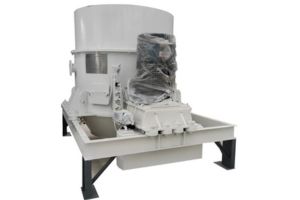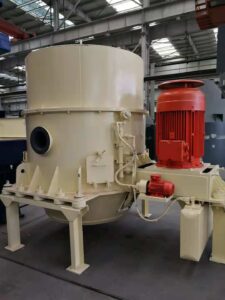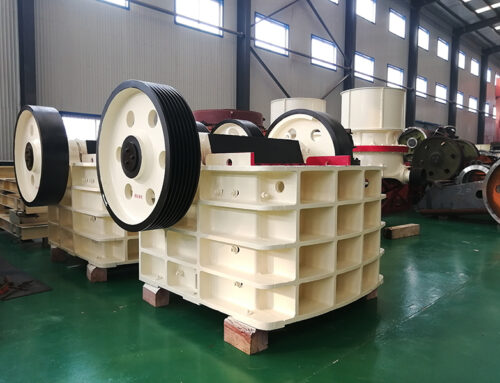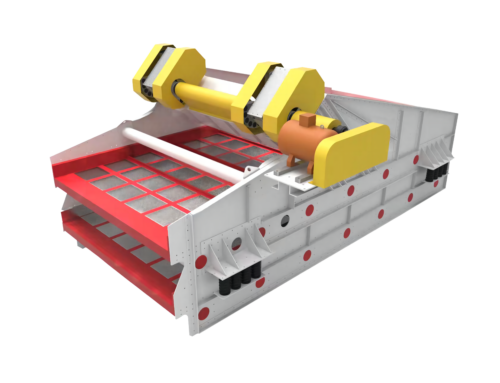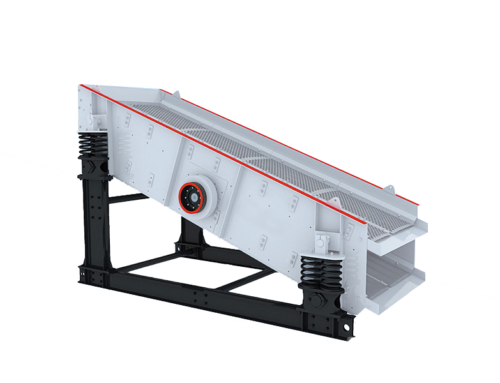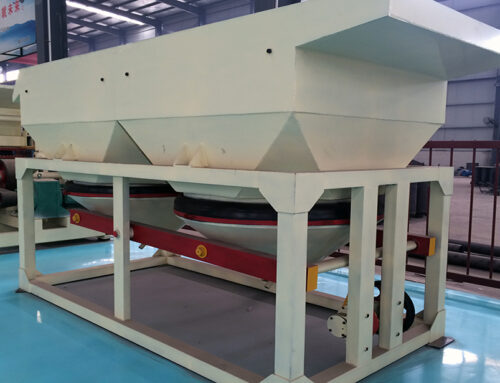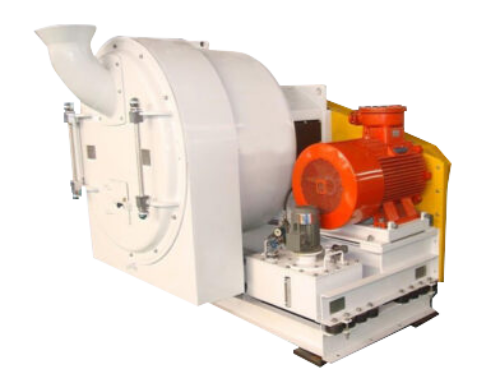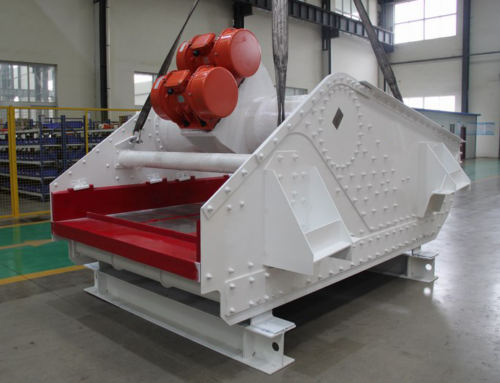Gypsum centrifuge is mainly composed of hydraulic system, power system, drum and other parts. The drum is composed of cylindrical and round platform-shaped cylinder connected coaxially, with a feeding port at the end of the cover, a gypsum slag discharge port below, and a liquid outlet port on the side of the shell, which makes the liquid discharge smooth. It has the features of short separation time, good separation effect and energy saving. The power is transmitted from the motor to the main shaft by belt, and the main shaft drives the drum to rotate and separate, and the size of the drum varies from 1600mm – 1000mm. It is mainly used for desulphurisation of sulphur dioxide in thermal power plants, waste incineration plants, cement plants etc. Advantage lies in the small energy consumption, only in the feed and acceleration of full power, other time low power operation; rinsing liquid dosage is small, reduce costs; covers an area of small, only 1/3 of the vacuum filtration belt; closed automation system, operation is environmentally friendly and convenient; maintenance costs are low. Compared with the vacuum filter belt, although the purchase cost is slightly higher, but the failure rate is low, the use cost is low and the service life is long, and the total cost is much lower than the vacuum filter belt.
一.Wide application of centrifuge in gypsum industry
Centrifuges are widely used in gypsum industry, especially in thermal power plants, waste incineration plants, cement plants and other fields. In thermal power plants, gypsum produced by FGD wet flue gas desulphurisation (FGD) technology can be separated from the mother liquor by centrifuges, and the finished products can be used to make gypsum boards for building, etc. In the waste incineration plant, centrifuge also plays an important role. It can separate the gypsum from the complex mixture efficiently, ensuring the maximum dewatering capacity of gypsum slurry to meet the production needs. What’s more, the fully enclosed, automated centrifugal separation system is more environmentally friendly and convenient to operate, reducing maintenance and servicing costs. In cement plants, centrifuges can be used to treat gypsum produced from sulphur oxides in the kiln exhaust gas of cement clinker production lines. If wet desulphurisation is used, gypsum with 10% – 15% water content can be obtained through centrifuges, and this quality of gypsum can partially replace the gypsum used in the cement grinding process.
In addition, the centrifuge’s efficient separation action helps to improve the recycling rate of gypsum and reduce production costs. At the same time, it also plays a positive role in reducing the emission of sulfur oxides in the exhaust gas, thus achieving a win-win situation for environmental protection and economic benefits. In actual application, the parameters of the centrifuge need to be optimised and adjusted according to different production processes and needs to ensure stable operation and the best processing effect.
二.Solid-liquid separation process in gypsum dewatering
Charging
Prior to charging, the sorter installed at the solids discharge nozzle is transferred to the liquid discharge position, which prevents liquid flow to the next solids process step. Suspended gypsum can be fed uniformly into the dewatering drum through two feed pipes, and a liquid level control prevents overfilling of the dewatering drum.
Primary Centrifugal Dewatering
The dehydrator drum should be rotated at an accelerated rate to dewater a portion of the cake.
Flushing
After intermediate dewatering and separation, a rinse hose is used to apply the rinse solution uniformly to the cake product and to wash out impurities (mainly oxides).
Secondary dewatering
After rinsing, dewatering is carried out only if the required residual moisture content in the filter cake is achieved.
Scraping and solids discharge
Before scraping, the product sorter is transferred to the solids discharge position. At reduced speed, the scraper swings into the filter cake to scrape out the product.
Removal of residual cake
In order to protect the filter cloth during scraping, residual cake is generated on the filter cloth and the product sorter is transferred to the solids discharge position before removing the residual cake. Depending on the product characteristics and using a separate flushing hose, the residual cake can be removed periodically.
三.Advantages of centrifuges for gypsum industry
1.It can greatly improve the production efficiency. During the processing of gypsum slurries, centrifuges, with their powerful centrifugal force, can quickly and effectively separate the solid and liquid components. This process is not only efficient, but also precise, and can complete a large amount of separation work in a short period of time, which saves valuable time for the subsequent stages of gypsum production.
2.Centrifuges excel in reducing the moisture content of the product. The centrifugal force generated by the high speed rotation separates as much moisture as possible from the gypsum product, thus significantly improving the quality of the gypsum product. The reduced moisture content makes the gypsum product stronger and more durable, allowing it to perform better during use.
3.Some centrifuges have an extremely high degree of automation. This means that they can automate a range of operations during the production process, reducing the cost and labour intensity of manual operations. The operator only needs to carry out simple monitoring and adjustment to ensure the normal operation of the centrifuge. This automation not only improves production efficiency, but also reduces the risk of human error.
Finally, the different types of centrifuges are highly flexible and can adapt to the needs of gypsum production of different sizes. Whether you are a small gypsum producer or a large industrial production site, you can choose the right type of centrifuge according to your actual situation. This flexibility makes centrifuges widely used in the gypsum industry.
四.The specific application of centrifuges in gypsum production
1.Slurry thickening step
In the gypsum production process, the slurry thickening step is an important part. This step is achieved through the slurry thickening device, the device includes a frame, rotor and box shell. The rotor has a hollow cylindrical mesh screen structure with a spiral belt at the inner mesh wall for spiral feeding. Gypsum dilute slurry enters through the inlet of the rotary drum, and is gradually dewatered with the rotation of the rotary drum to form gypsum thick slurry with a solid mass fraction of 20% to 30%. For example, in some large gypsum production enterprises, the use of this slurry thickening device, every hour can handle gypsum thin slurry 50 cubic metres, greatly improving production efficiency.
2.Slurry homogenisation step
The slurry homogenisation step relies on the slurry homogenisation device. The stirring section in the storage tank can prevent the slurry from settling, and the slurry enters the upper inlet of the storage tank through the discharge port of the slurry thickening device, and then discharges from the bottom discharge port, and then enters the centrifugal dewatering step through the material transfer pump. Through the slurry homogenisation, the gypsum slurry can be made more homogeneous and the effect of subsequent centrifugal dewatering can be improved. According to statistics, after the slurry homogenisation, the dehydration rate of gypsum slurry in the centrifugal dewatering process can be increased by about 10%.
3.Centrifugal dewatering step
Centrifugal dewatering step is the key link of gypsum production. Centrifugal dewatering device includes outer shell, drum, feeding pipe, washing pipe and scraper mechanism. The gypsum thick slurry enters the drum through the upper and lower feeding tubes, and goes through the sub-steps of feeding, dewatering, washing and scraping under different rotating speeds, and finally forms the finished product.
The centrifuge plays an important role in improving the quality of gypsum. By precisely controlling the parameters of each step, such as the degree of dewatering for slurry thickening, the stirring intensity for homogenisation, and the rotational speed of centrifugal dewatering, the impurities in gypsum can be effectively removed and the purity of gypsum can be improved. Meanwhile, in terms of reducing the degree of environmental threat, centrifuges can separate gypsum from wastewater, so that the impurities are concentrated in the discharge liquid, which reduces the pollution of the environment.
五.Important role of centrifuges in the gypsum industry
Centrifuges play a vital role in the gypsum industry. Firstly, centrifuges are highly efficient and precise in separating liquids and solids. Different types of centrifuges, such as gypsum centrifuges and GLZ gypsum centrifuges, for example, are able to quickly separate liquids from gypsum mixtures, so that the water content of gypsum filter cake is greatly reduced.
Secondly, the centrifuge significantly improves the efficiency of gypsum production. On the one hand, the automated operation of the centrifuge reduces manual intervention, such as the fully enclosed, automated centrifugal separation system, which is more environmentally friendly and convenient to operate, and reduces maintenance and repair costs. On the other hand, the centrifuge’s high-speed operation and continuous working ability make the gypsum processing capacity increase dramatically.
Furthermore, centrifuges play an important role in reducing costs. Although the centrifuge system purchase cost is slightly higher than the vacuum filter belt, but in the long term, its failure rate is low, low cost and long life. Normal operation can be 4 – 5 years, the total cost is much lower than other vacuum filter belt. At the same time, the centrifuge energy consumption is small, only in the feeding and acceleration of full power, other time low power operation; rinsing liquid consumption is small, reducing the cost of water.
To sum up, centrifuge has irreplaceable important role in gypsum industry. It not only realises the efficient separation of liquid and solid, improves the production efficiency, but also reduces the production cost, which provides a strong support for the development of gypsum industry.

